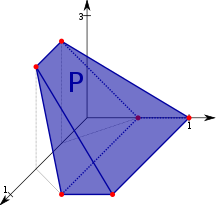
Back Polítop convex Catalan Konvexes Polytop German Κυρτό πολύτοπο Greek Politopo convexo Spanish Politop cembung ID 볼록 다포체 Korean Polítopo convexo Portuguese Politop convex Romanian Опуклий політоп Ukrainian محدب کثیر سطحی Urdu

A convex polytope is a special case of a polytope, having the additional property that it is also a convex set contained in the -dimensional Euclidean space . Most texts[1][2] use the term "polytope" for a bounded convex polytope, and the word "polyhedron" for the more general, possibly unbounded object. Others[3] (including this article) allow polytopes to be unbounded. The terms "bounded/unbounded convex polytope" will be used below whenever the boundedness is critical to the discussed issue. Yet other texts identify a convex polytope with its boundary.
Convex polytopes play an important role both in various branches of mathematics and in applied areas, most notably in linear programming.
In the influential textbooks of Grünbaum[1] and Ziegler[2] on the subject, as well as in many other texts in discrete geometry, convex polytopes are often simply called "polytopes". Grünbaum points out that this is solely to avoid the endless repetition of the word "convex", and that the discussion should throughout be understood as applying only to the convex variety (p. 51).
A polytope is called full-dimensional if it is an -dimensional object in .
- ^ a b Cite error: The named reference
grunwas invoked but never defined (see the help page). - ^ a b Ziegler, Günter M. (1995), Lectures on Polytopes, Graduate Texts in Mathematics, vol. 152, Berlin, New York: Springer-Verlag.
- ^ Mathematical Programming, by Melvyn W. Jeter (1986) ISBN 0-8247-7478-7, p. 68

